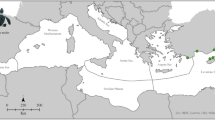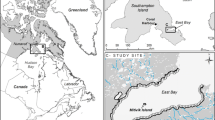Abstract
Climate change is expected to result in an acceleration of current rates of sea level rise, inundating many low-lying coastal and intertidal landscapes. This could have important implications for many coastal habitat types and related organisms that depend on these habitats, including shorebirds that rely on them for feeding, overwintering and breeding. Potential change in the availability of suitable breeding area according to linear and model-based sea level rise scenarios was modeled for four breeding birds (Kentish Plover, Little Tern, Common Tern and Black-winged Stilt) in Sečovlje Salina Nature Park, based on precise mapping of nests over a period of 10 years and on present environmental predictors. Different breeding niches for the studied bird species in SSNP were identified, which indirectly indicates different responses to environmental change, in this case triggered by climate change induced sea level rise. Future breeding suitability maps indicate that the Little Tern and the Common Tern could potentially face a drastic decrease of adequate breeding grounds in SSNP later than the Kentish Plover and the Black-winged Stilt. However, these individual species responses to sea level rise, as a climate change driver, is a step forward for conservation biologists and landscape planners in protected areas, as they prepare cost-effective plans for mitigating negative impact on these ecosystems. This study also illustrates an important general point about the likely effects of climate change on ecological resources, which is that climate change does not happen in a vacuum; its impact will interact with pre-existing stress factors.




Similar content being viewed by others
References
Adam P (2002) Saltmarshes in a time of change. Environ Conserv 29:39–61
Anonymous (2007) Interpretation manual of European Union habitats. European commission DG Environment: 144. http://ec.europa.eu/environment/nature/legislation/habitatsdirective/docs/2007_07_im.pdf. Pridobljeno 20. 12.2011
ARSO (2011) Slovenian environmental agency. http://kazalci.arso.gov.si/?data=indicatorandind_id=146. Accessed 20 Dec 2011
Bibby CJ, Burgess D, Hill DA (1992) Bird Census technique. Academy Press, London
BirdLife International (2012a) Charadrius alexandrinus. In: IUCN 2013. IUCN Red List of Threatened Species. Version 2013.2. <www.iucnredlist.org>. Downloaded on 02 April 2014
BirdLife International (2012b) Himantopus himantopus. In: IUCN 2013. IUCN Red List of Threatened Species. Version 2013.2. <www.iucnredlist.org>. Downloaded on 02 April 2014
BirdLife International (2012c) Sterna albifrons. In: IUCN 2013. IUCN Red List of Threatened Species. Version 2013.2. <www.iucnredlist.org>. Downloaded on 02 April 2014
Church JA et al (2013) Sea level change. In: TF S, Qin D, G-K P, Tignor M, SK A, Boschung J, Nauels A, Xia Y, Bex V, PM M (eds) Climate change 2013: the physical science basis, contribution of working group I to the fifth assessment report of the intergovernmental panel on climate change. Cambridge University Press, Cambridge
Cramp S, Simmons KEL (1983) The birds of the western Paleartic, vol 3. Oxford University Press, Oxford
Development Core Team R (2008) R: a language and environment for statistical computing. R Foundation for Statistical Computing, Vienna ISBN 3-900051-07-0, http://www.Rproject.org
Devictor V, Van Swaay C, Brereton T, Brotons L, Chamberlain D, Heliölä J, Herrando S, Julliard R, Kuussaari M, Lindström A, Reif J, Roy DB, Schweiger O, Settele J, Stefanescu C, Van Strien A, Van Turnhout C, Vermouzek Z, WallisDeVries M, Wynhoff I, Jiguet F (2012) Differences in the climatic debts of birds and butterflies at a continental scale. Nat Clim Chang 2:121–124
Devilliers P, Devilliers-Terschuren J (1996) A classification of Palearctic habitats. Council of Europe, Nature and environment, Strasbourg, p 78
Eastman JR (2012) IDRISI Selva. Clark University, Worcester
ESRI (2010) ArcGIS desktop: release 9.3. Environmental Systems Research Institute, Redlands
Fuentes M, Limpus CJ, Hamman M, Dawson J (2010) Potential impacts of projected sea-level rise on sea turtle rookeries. Aquat Conserv Mar Freshwat Ecosyst 20:132–139
Galbraith H, Jones R, Park R, Clough J, Herrod-Julius S, Harrington B, Page G (2002) Global climate change and sea level rise: potential losses of IntertidalH abitatf or shorebirds. Waterbirds 25(2):173–183
Gallo KP, Owen TW (1999) Satellite based adjustments for the urban heat island temperature bias. J Appl Meteorol 38:806–813
Gregory RD, Willis SG, Jiguet F, Voříšek P, Klvaňová A, van Strien A, Huntley B, Collingham YC, Couvet D, Green RE (2009) An indicator of the impact of climatic change on European bird populations. PLoS One 4(3):4678. doi:10.1371/journal.pone.0004678
GURS (2013) Geodetska Uprava Republike Slovenije (The surveying and mapping authority of the Republic of Slovenia, Ministry of Infrastructure and Spatial Planning), Ljubljana
Halpern BS, Walbridge S, Selkoe KA, Kappel CV, Micheli F, D’Agrosa C, Bruno JF, Casey KS, Ebert C, Fox HE, Fujita R, Heinemann D, Lenihan HS, Madin EMP, Perry MT, Selig ER, Spalding M, Steneck R, Watson R (2008) A global map of human impact on marine ecosystems. Science 319:948–952
Ivajnšič D, Kaligarič M (2014) How to preserve coastal wetlands, threatened by climate change-driven rises in sea level. Environ Manag:1–14. doi:10.1007/s00267-014-0244-8
Jenness J, Brost B, Beier P (2013) Land facet corridor designer. Arizona Board of Forest Research. http://www.jennessent.com/downloads/Land_Facet_Tools.pdf
Jiguet F, Devictor V, Ottvall R, Van Turnhout C, Van der Jeugd H, Lindström A (2010) Bird populations trends are linearly affected by climate change along species thermal ranges. Proc R Soc B. doi:10.1098/rspb.2010.0796
Johnston A, Ausden M, Dodd AM, Bradbury RB, Chamberlain DE, Jiguet F, Thomas CD, Cook ASCP, Newson SE, Ockendon N, Rehfisch MM, Roos S, Thaxter CB, Brown A, Crick HQP, Douse A, McCall RA, Pontier H, Stroud DA, Cadiou B, Crowe O, Deceuninck B, Hornman M, Pearce-Higgins JW (2013) Observed and predicted effects of climate change on species abundance in protected areas. Nat Clim Chang. doi:10.1038/NCLIMATE2035
Kumar S, Stohlgren TJ (2009) MaxEnt modeling for predicting suitable habitat for threatened and endangered tree Canacomyrica monticola in New Caledonia. J Ecol Nat Environ 4:94–98
Lambeck K, Antonioli F, Purcell A, Silenzi S (2004) Sea-level change along the Italian coast for the past 10,000 year. Quat Sci Rev 23:1567–1598
Liu C, Berry PM, Dawson TP, Pearson RG (2005) Setting thresholds of occurrence in the prediction of species distributions. Ecography 28(3):385–393
Lobo JM, Jiménez-Valverde A, Real R (2008) AUC: a misleading measure of the performance of predictive distribution models. Glob Ecol Biogeogr 17(2):145–151
Lombard AT, Cowling RM, Pressey RL, Rebero AG (2003) Effectiveness of land classes as surrogates for species in conservation planning for the cape floristic region. Biol Conserv 112:45–62
Millennium Ecosystem Assessment (2005) Ecosystems and human well-being: synthesis. Island Press, Washington, DC
Moudry V, Šimova P (2013) Relative importance of climate, topography, and habitats for breeding wetland birds with different latitudinal distributions in the Czech Republic. Appl Geogr 44:165–171
Ogorelec B, Mišič M, Faganeli J (1991) Marine geology of the Gulf of Trieste (northern Adriatic): sedimentological aspects. Mar Geol 99:79–92
Phillips SJ, Anderson RP, Schapire RE (2006) Maximum entropy modeling of species geographic distributions. Ecol Model 190:231–259
Phillips SJ, Dudík M, Elith J, Graham CH, Lehmann A, Leathwick J, Ferrier S (2009) Sample selection bias and presence-only distribution models: implications for background and pseudo-absence data. Ecol Appl 19:181–197
Pontius RG Jr, Parmentier B (2014) Recommendations for using the relative operating characteristicc (ROC). Landsc Ecol. doi:10.1007/s10980-013-9984-8
Pressey RL, Cabeza M, Watts ME, Cowling RM, Wilson KA (2007) Conservation planning in a changing world. Trends Ecol Evol 22(11):583–592
Scarton F (2010) Long term decline of a common tern (Sterna hirundo) population nesting in salt marshes in Venice lagoon, Italy. Wetlands 30:1153–1159
Scarton F, Valle R (1999) The use of dredge islands by birds in northern Adriatic lagoons. Avocetta 23:75
Schulz R, Stoch M (1993) Kentish plovers and tourists: competitors on sandy coasts? Wader Study Group Bullettin 68:83–91
Seavey J, Glimer B, McGarigal K (2011) Effect of sea-level rise on piping plover (Charadrius melodus) breeding habitat. Biol Conserv 144:393–401
Škornik I (2012) Faunistic and ecologic survey of birds in the Sečovlje Salina. Schwartz Publisher, KPSS, pp. 1–279
Škornik I, Makovec T, Lipej L (1995) Sečovlje Salina - an ornithological assessment of Slovene coastal wetland. Ann Ser Hist Nat 7:89–94
Slangen ABA, Adloff F, Javrejeva S, Leclercq PW, Marzeion B, Wada Y, Winkelmann R (2016) A review of recent updates of seal-level projections at global and regional scales. Surv Geophys:1–22. doi:10.1007/s10712-016-9374-2
Slater H, Michael E (2012) Predicting the current and future potential distributions of lymphatic Filariasis in Africa using maximum entropy ecological niche modelling. PLoS One 7(2):1–14
Thorne LH, Johnston DW, Urban DL, Bejder L, Baird RW, Yin S, Rickards SH, Deakos MH, Mobley JR Jr, Pack AA, Chapla Hill M (2012) Predictive modeling of spinner dolphin (Stenella longirostris) resting habitat in the main Hawaiian islands. PLoS One 7(8):e43167. doi:10.1371/journal.pone.0043167
Thuiller W, Albert C, Araujo MB, Berry PM, Cabeza M, Guisan A, Hickler T, Midgley GF, Peterson J, Schurr FM, Sykes MT, Zimmermann NE (2008) Predicting global change impacts on plant species’ distributions: future challenges. Perspect Plant Ecol Evol Syst 9:137–152
Tucker CJ (1979) Red and photographic infrared linear combinations for monitoring vegetation. Remote Sens Environ 8:27–150
Valle R, Scarton F (1999) Habitat selection and nesting association in four species of Charadriiformes in the Po Delta (Italy). Ardeola 46(1):1–12
Van Vuuren DP, Edmonds J, Kainuma M, Riahi K, Thomson A, Hibbard K, Hurtt GC, Kram T, Krey V, Lamarque J-F et al (2011) The representative concentration pathways: an overview. Clim Chang 109:5–31
Worm B, Barbier EB, Beaumont N, Duffy JE, Folke C, Halpern BS, Jackson JBC, Lotze HK, Micheli F, Palumbi SR, Sala E, Selkoe KA, Stachowicz JJ, Watson R (2006) Impacts of biodiversity loss on ocean ecosystem services. Science 314:787–790
Yozzo DJ, Wilber P, Will RJ (2004) Beneficial use of dredge materialfor habitat creation, enhancement, and restoration in New York—New Jersey Harbor. J Environ Manag 73:39–52
Author information
Authors and Affiliations
Corresponding author
Rights and permissions
About this article
Cite this article
Ivajnšič, D., Lipej, L., Škornik, I. et al. The sea level rise impact on four seashore breeding birds: the key study of Sečovlje Salina Nature Park. Climatic Change 140, 549–562 (2017). https://doi.org/10.1007/s10584-016-1854-3
Received:
Accepted:
Published:
Issue Date:
DOI: https://doi.org/10.1007/s10584-016-1854-3




